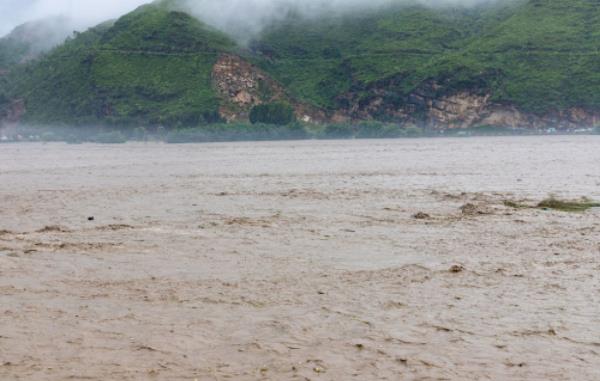11 October 2022

Recent floods in Pakistan have caused widespread devastation – putting critical communications under the spotlight. Robert Shepherd speaks to those keeping southern Asia connected
The recent flooding that’s engulfed Pakistan is a stark reminder to humanity that we are always at the mercy of Mother Nature.
Whether it’s to do with climate change – spoiler alert: there is no global warming debate here, so look elsewhere if that’s what you seek – war, nuclear disasters, terrorism or badly-constructed buildings, human life can be changed dramatically, if not ended, on a whim. This latest tragedy is proof of this if further proof be needed.
Furthermore, if it wasn’t for wireless communications, we wouldn’t be as informed about this disaster as we are.
For example, recent images taken from NASA’s MODIS satellite showed the massive impact of heavy rain and an overflowing Indus – a trans-Himalayan river of south and central Asia - which has flooded the Sindh province in southern Pakistan.
Operational land imagers aboard NASA’s Landsat 8 and Landsat 9 satellites took images of the country on August 4 and 28, the Earth Observatory of National Aeronautics and Space Administration (NASA) reported.
At the time of writing, Pakistan has the unenviable task of reporting just under 1,500 dead, millions displaced – and a vast swathe of croplands submerged. It’s the country’s worst floods for 10 years.
“Recent global emergencies should focus mission critical users on the importance of fast, secure communications and the ability to rapidly deploy the most appropriate technology for any situation and in any geographic area is essential,” says Paul Ward, director, ETELM. “A perfect example is where ETELM working with B-LIFE deployed a system combining both TETRA and 4G for Covid emergencies in Italy.”
More on TETRA later, but the good news is there’s a plethora of different technologies at our disposal, like the kit utilised by NASA. Satellite has a long history of providing critical communications connectivity services to first responders – be they NGOs, international/government agencies, or the military – who must have resilient communications to enable effective decision-making in the field.
Martin Jarrold, VP international programme development at GVF says the more recent history of the satellite industry supporting the humanitarian community is exemplified in its global collaboration with the United Nations Crisis Connectivity Charter; to the development of which GVF (along with several member organisations) significantly contributed. “With the support of the Emergency Telecommunications Cluster of the World Food Programme and the UN office for the Coordination of
Humanitarian Affairs, the Charter greatly enhances the humanitarian community’s access to vital satellite-based communications when local networks are affected, destroyed or overloaded following disasters, providing immediate, resilient connectivity within 24 hours,” he adds.
Ildefonso de la Cruz, a principal analyst in the public safety & critical communications group at OMDIA, says that the benefits offered (by broadband technology) to mission-critical communications (MCC) by addressing their demands for data-rich features and services are unquestionable.

Subodh Vardhan, vice president, southeast Asia, Motorola Solutions.
“However, the network planning models selected for their implementation vary in every region. In contrast to Europe and North America which have opted for nationwide public safety broadband networks (PSBN), Asian countries show a preference for dedicated local public safety network buildouts,” argues de la Cruz. “At the end of 2021, Asia Pacific led the way with 57% of the investment in dedicated broadband mission-critical networks. The Asian market investment in mission-critical broadband devices is expected to reach US$1bn by 2025.”
Sepura, headquartered in Cambridge, England, has a rich history in Asia. The company supplies digital radio solutions, complementary accessories, support tools and devices in the critical comms space.
Koh Cheng Soi, business development manager, Asia, Sepura explains what his company has been doing in southern Asia to keep the region connected.
“Sepura has continued to supply our customers in public safety, transportation and airports with critical comms solutions,” he says. “In particular we have seen significant take up of new TETRA solutions from transport organisations in India, with a number of lines adopting Sepura radios as standard for their communication needs. We continue to supply major public safety forces with handheld and vehicle radios and are increasingly seeing interest in new variants of our solutions; VHF TETRA for those operating in very large outdoor areas, and LTE dual mode solutions for those looking to incorporate mass data into their communications.”
Indeed, the traditional markets for TETRA are still those deploying solutions today; these include police, fire, ambulance, transport, airports, utilities and oil and gas plants. Soi says Sepura, in particular, has seen a lot of demand from new transport infrastructure, including city metro and light rails and airports.
“TETRA is still the standard choice for users operating in mission critical environments – that is where there is a risk to life or to critical national infrastructure,” Soi continues. “In certain countries where LTE band is available for mission critical, government has started planning/ adopting mission critical LTE into their existing TETRA network for Hybrid TETRA/LTE network or some going for mission critical LTE network in specific sector.
We are increasingly seeing interest for hybrid LTE/TETRA, with a constant demand to maintain TETRA for voice due to its proven reliability and security.”
Motorola Solutions has long had an expansive reach with LMR systems for public safety and commercial organisations throughout the Asia Pacific region.
It supplies many LMR systems and subscribers across multiple industries and projects, many of which are based on the TETRA and P25 standards which customers continue to depend on for secure and reliable team-based communications.
“Public safety continues to be an industry in which we are seeing considerable demand for our mission critical communications solutions,” says Subodh Vardhan, vice president, southeast Asia, Motorola Solutions.

Martin Jarrold VP international programme development, GVF
“This has particularly been the case throughout the Covid-19 pandemic when government and public safety agencies needed to continue delivering their services both in the field and remotely with back-office functions supporting frontline technology users from the comfort and safety of their homes.”
He adds that this has driven the need both for greater investment in LMR technologies as a means for secure communications and to support contactless operations.
“But it has also driven the need for integration of broadband technologies with LMR to enable seamless communication between two-way radio users on the frontline and users of smartphones, desktop computers and other devices working in their homes or at other remote locations,” Vardhan continues. “As the economic recovery from Covid-19 continues throughout the region, we’re also addressing the pent- up demand for LMR systems and devices which organisations are investing in as part of their recovery.”
There are other companies making major inroads in southern Asia, too. It was recently announced that the Tactilon Agnet 500 developed by Airbus Secure Land Communications (SLC) is now fully operational in India in collaboration with Arubaito and Bharat Sanchar Nigam Limited (BSNL), following a phase of implementation and testing.
The state-of-the-art mission-critical communication Service (MCS) for business and mission-critical users is based on the mobile telecommunications standard of the 3rd Generation Partnership Project (3GPP). As a future-proof modern, easy-to-use, flexible and scalable solution, Tactilon Agnet 500 can acquire and transmit data, video and voice to all relevant bodies at once – securely and reliably, the partners said.
What’s more, the technology allows radio-device, smartphone, tablet, and laptop users to communicate individually, or in a group.
“Tactilon Agnet 500 is a complete solution and its deployment in India is a real success thanks to the strength of the BSNL network,” says Selim Bouri, vice-president for Airbus SLC in Africa, Asia and the Middle East.

Koh Cheng Soi, business development manager, Asia, Sepura
“Terrain is no more an issue in Asia than anywhere else in the world – it is just another factor that needs to be included when planning a properly deployed network”
P.K. Purwar, CMD BSNL, adds: “As one of the largest wireless telecommunications service providers in India, BSNL is proud to have enabled the deployment of Tactilon Agnet 500 in collaboration with Airbus SLC. This is a real breakthrough for mission-critical communications offering to our professional/enterprise customers.”
In 2020, during the height of the Covid-19 pandemic, Petroleum Authority of Thailand (PTT) has chosen a bridged TETRA solution from DAMM Cellular Systems for the replacement of the radio communication system used for their Gas Separation Plant (GSP).
Included in the redundant, decentralised solution are base stations, dispatchers, log server, network management system and DAMM’s smartphone solution as well as a DAMM TetraFlex Group Bridge that bridges to the existing system.
Witchukorn Naewwong, business director at DAMM partner Seanet Asia, explains that PTT chose a DAMM solution because, “It guaranteed cost-efficiency, low power consumption, flexibility and scalability. And just as importantly it let them bridge to their existing system, enabling them to perform a less cost-heavy gradual replacement”.
Naewwong also explains that “it solves the problem that PTT had with an outdated TETRA solution and bridges seamlessly to their existing system in exactly the way they needed it to. On top of that the open API allows them to easily integrate third-party applications, allowing them to customise the solution to their exact needs and saving on costs for new applications”.
Looking to the future, Ward adds that private 4G/5G communications offers an exciting opportunity for mission critical users – the move towards high-speed broadband services will enable new, advanced applications and offer significant operational improvements for users. He cites TETRA as “still the most advanced digital trunked communications system for mission critical users today and sets the standard for voice and group communications” but will never be able to offer the high-speed data services that are essential for today’s critical workers.
“As organisations look towards the next generation mobile communications, there is an opportunity to reflect on how different technologies can continue to be viable for users,” Ward continues. “Traditional narrowband PMR technologies will be required well into the future…issues of affordability, spectrum availability, cell coverage and re-use of existing subscriber equipment are all likely to be factors. We believe that a hybrid approach to technologies is the ideal solution to allow users the best choice; and a fully integrated, single network solution will always be a better solution than gateways to separate networks.”
Ward further argues that an opportunity now exists for manufacturers of all standard PMR technologies to adopt the same approach and develop their technology into the 3GPP standards for core networking – LTE Core, 5G NR. He says this could create a single eco-system for all mobile communications and allow users to select and mix technologies based on cost, service and user requirements. “4GLinked TETRA base stations adopt this approach as they can connect directly to any LTE Core network in the same way as any LTE eNodeB, by utilising the LTE-S1 connectivity standard,” Ward continues. “This allows our TETRA system to be deployed over the same, single network core solution alongside 4G and future 5G base stations. The solution has been tested at 3GPP Plug tests and already deployed in many different scenarios for emergency services.”
No country has the same terrain and topography as the next, which means the method of deployment when it comes to technology can pose different sets of problems.
Soi says this is always best answered on a case-by-case basis, as every network deployment is based on a number of factors, including geography and available spectrum.
“However, the launch of our VHF TETRA solution is significant, as this opens TETRA to users who have this spectrum available to them but have not previously had the opportunity to deploy TETRA radios as nothing has been available to them,” he adds. “This is particularly the case for transport organisations and other commercial organisations across Asia.”
More specifically, then – how much of a challenge is deployment in southern Asia?
“Terrain is no more an issue in Asia than anywhere else in the world – it is just another factor that needs to be included when planning a properly deployed network,” Soi adds. “The key is proper planning and engagement with suppliers, who can help organisations deliver a critical communications solution to match their needs. This is why TETRA is and continues to be the primary choice for critical comms users across the region.”
Regardless of the causes of a tragedy – natural or manmade – one thing is for sure, critical communications is more important than ever before, according to Mladen Vratonjić, board chair of TCCA, the global representation organisation for the critical communications ecosystem.
“It has been proven time and time again, all around the world, that having robust and reliable communications systems is essential when managing major events, whether planned or unplanned,” he says. “This encourages competition, helping to keep quality levels up and costs down, ensuring a wide choice of suppliers, catalysing innovation and preventing the emergence of expensive proprietary products. We would urge governments of all African countries to ensure they are implementing the best possible services for their first responders and emergency services – the quality of the communications can be the difference between effectively managing a crisis situation, or seeing a disaster turn into a tragedy.”
Soi’s colleague Terence Ledger, worldwide sales director, Sepura, sums it up when he explains that natural disasters around the world remind us of the fragility of the status quo in vulnerable locations. As a result, preparation for dealing with such situations is vital and this includes technology and equipment to support such responses, as well as the learning from experiences and other situations around the world. “Mission critical communications solutions are of course a key element of this – being the key tool to join together operational forces,” Ledger adds. “In these environments, tough, dependable devices are paramount – water resistance, robust design and the ability to provide loud, clear audio are vital to ensuring rescue operations can be properly fulfilled.”
While southern Asia does continue to face challenges in the critical comms space - be they cultural, financial, political or something else, the will is there. Like many things, progress takes time. At least we have the tech.






